MNG81001 Management Communication: Virtual Teams Persuasive Memo
VerifiedAdded on 2023/06/03
|5
|1157
|55
Report
AI Summary
This persuasive memo addresses the management of virtual teams, particularly in the context of a globalized marketing team with members in Sydney, Beijing, Mumbai, and New York. It outlines the advantages of virtual teams, such as cost reduction, access to global talent, and increased productivity through seamless communication and knowledge sharing. The memo also acknowledges the challenges, including reliance on technology and potential communication gaps, and proposes solutions like utilizing both synchronous and asynchronous communication methods, establishing clear team missions, and promoting face-to-face meetings to foster cohesion. The document concludes by emphasizing the importance of robust management and a favorable working environment to maximize the benefits of virtual teams.
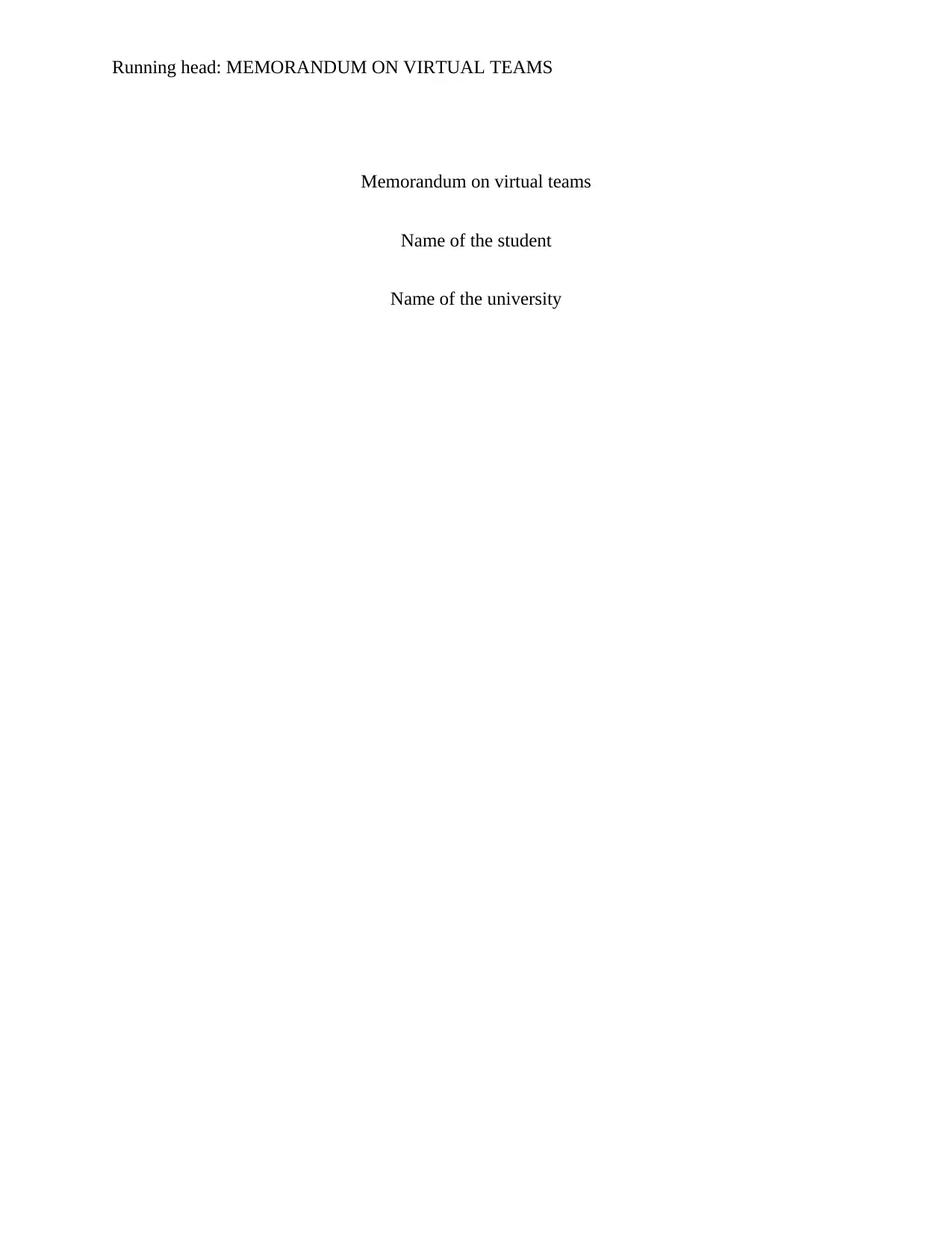
Running head: MEMORANDUM ON VIRTUAL TEAMS
Memorandum on virtual teams
Name of the student
Name of the university
Memorandum on virtual teams
Name of the student
Name of the university
Paraphrase This Document
Need a fresh take? Get an instant paraphrase of this document with our AI Paraphraser
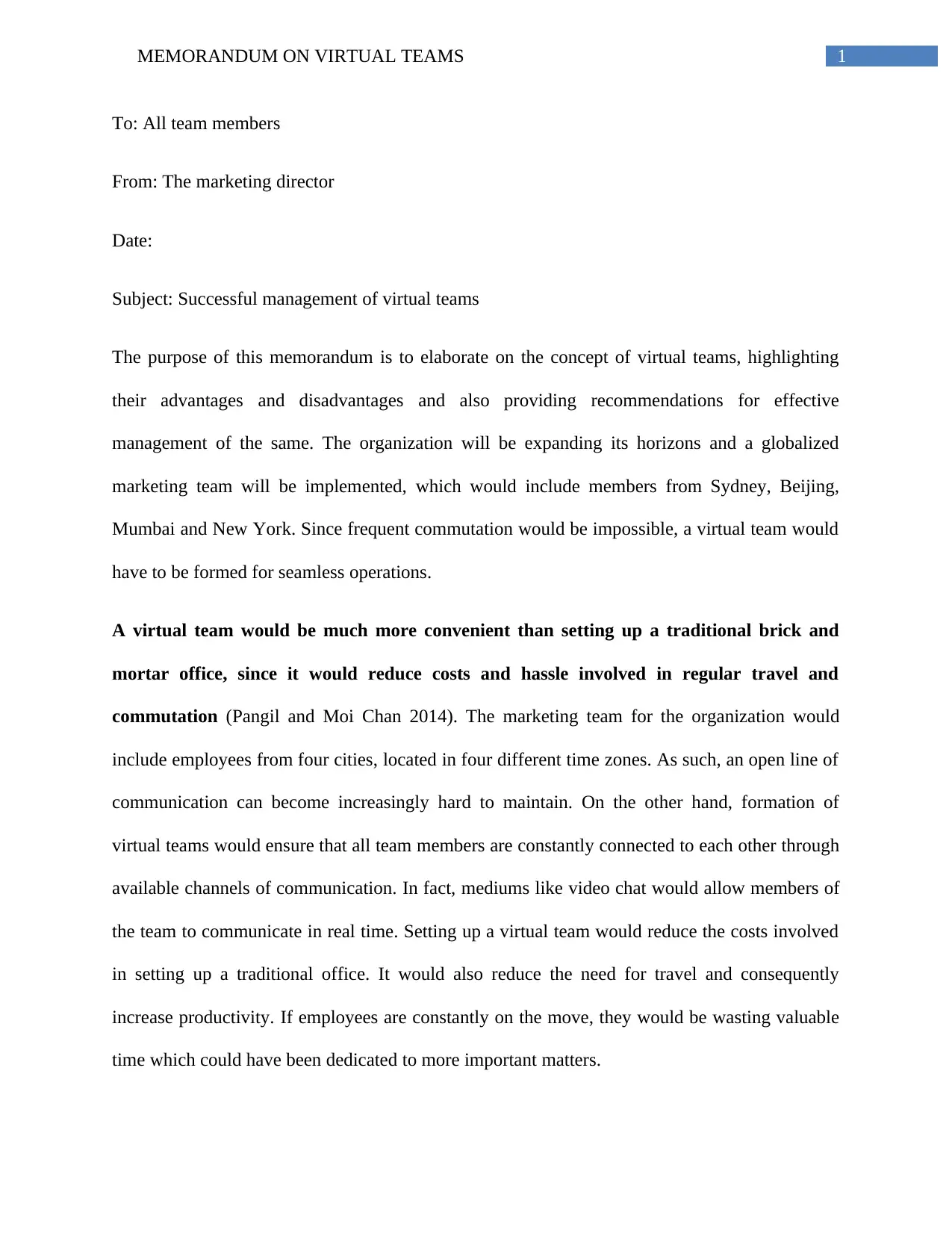
1MEMORANDUM ON VIRTUAL TEAMS
To: All team members
From: The marketing director
Date:
Subject: Successful management of virtual teams
The purpose of this memorandum is to elaborate on the concept of virtual teams, highlighting
their advantages and disadvantages and also providing recommendations for effective
management of the same. The organization will be expanding its horizons and a globalized
marketing team will be implemented, which would include members from Sydney, Beijing,
Mumbai and New York. Since frequent commutation would be impossible, a virtual team would
have to be formed for seamless operations.
A virtual team would be much more convenient than setting up a traditional brick and
mortar office, since it would reduce costs and hassle involved in regular travel and
commutation (Pangil and Moi Chan 2014). The marketing team for the organization would
include employees from four cities, located in four different time zones. As such, an open line of
communication can become increasingly hard to maintain. On the other hand, formation of
virtual teams would ensure that all team members are constantly connected to each other through
available channels of communication. In fact, mediums like video chat would allow members of
the team to communicate in real time. Setting up a virtual team would reduce the costs involved
in setting up a traditional office. It would also reduce the need for travel and consequently
increase productivity. If employees are constantly on the move, they would be wasting valuable
time which could have been dedicated to more important matters.
To: All team members
From: The marketing director
Date:
Subject: Successful management of virtual teams
The purpose of this memorandum is to elaborate on the concept of virtual teams, highlighting
their advantages and disadvantages and also providing recommendations for effective
management of the same. The organization will be expanding its horizons and a globalized
marketing team will be implemented, which would include members from Sydney, Beijing,
Mumbai and New York. Since frequent commutation would be impossible, a virtual team would
have to be formed for seamless operations.
A virtual team would be much more convenient than setting up a traditional brick and
mortar office, since it would reduce costs and hassle involved in regular travel and
commutation (Pangil and Moi Chan 2014). The marketing team for the organization would
include employees from four cities, located in four different time zones. As such, an open line of
communication can become increasingly hard to maintain. On the other hand, formation of
virtual teams would ensure that all team members are constantly connected to each other through
available channels of communication. In fact, mediums like video chat would allow members of
the team to communicate in real time. Setting up a virtual team would reduce the costs involved
in setting up a traditional office. It would also reduce the need for travel and consequently
increase productivity. If employees are constantly on the move, they would be wasting valuable
time which could have been dedicated to more important matters.
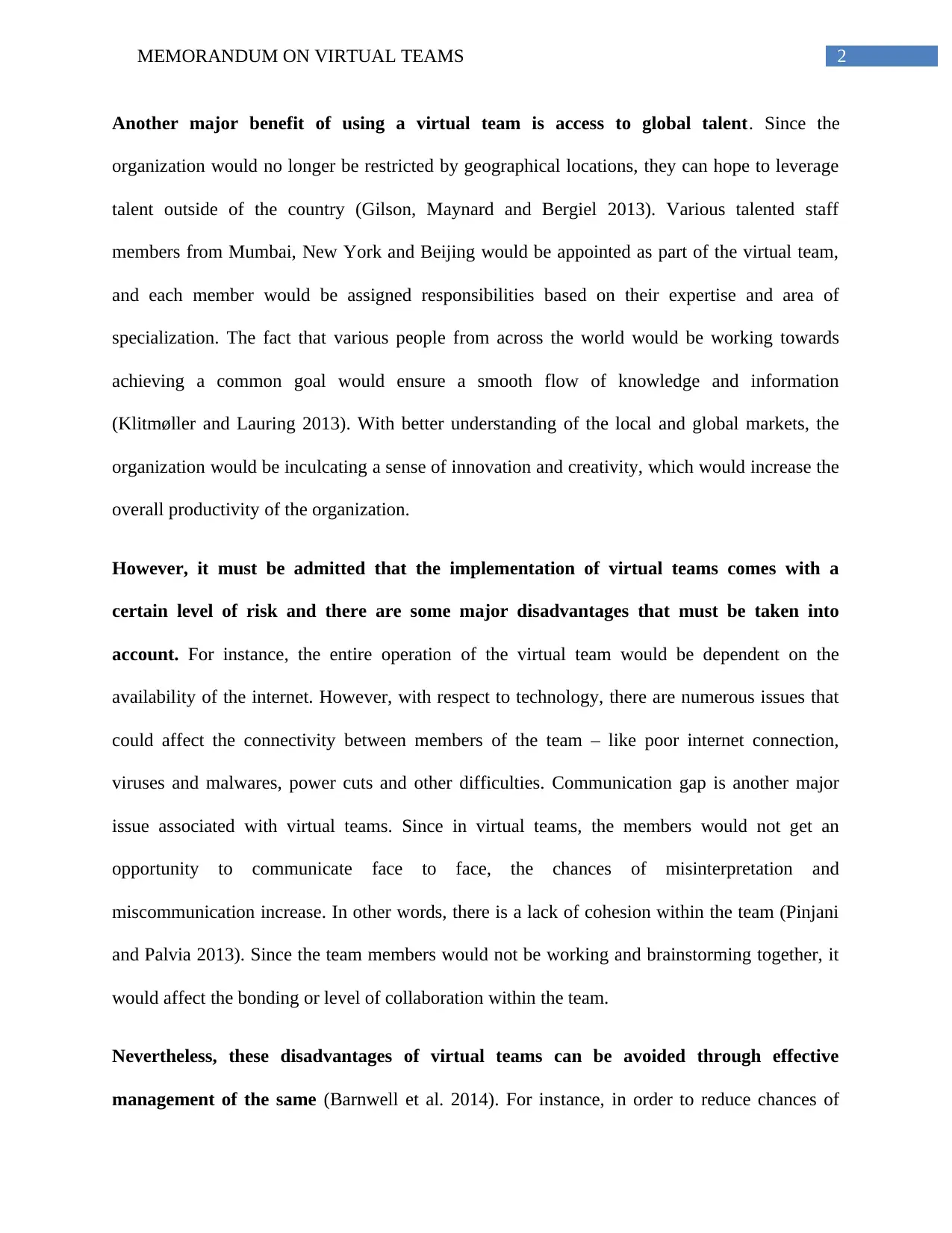
2MEMORANDUM ON VIRTUAL TEAMS
Another major benefit of using a virtual team is access to global talent. Since the
organization would no longer be restricted by geographical locations, they can hope to leverage
talent outside of the country (Gilson, Maynard and Bergiel 2013). Various talented staff
members from Mumbai, New York and Beijing would be appointed as part of the virtual team,
and each member would be assigned responsibilities based on their expertise and area of
specialization. The fact that various people from across the world would be working towards
achieving a common goal would ensure a smooth flow of knowledge and information
(Klitmøller and Lauring 2013). With better understanding of the local and global markets, the
organization would be inculcating a sense of innovation and creativity, which would increase the
overall productivity of the organization.
However, it must be admitted that the implementation of virtual teams comes with a
certain level of risk and there are some major disadvantages that must be taken into
account. For instance, the entire operation of the virtual team would be dependent on the
availability of the internet. However, with respect to technology, there are numerous issues that
could affect the connectivity between members of the team – like poor internet connection,
viruses and malwares, power cuts and other difficulties. Communication gap is another major
issue associated with virtual teams. Since in virtual teams, the members would not get an
opportunity to communicate face to face, the chances of misinterpretation and
miscommunication increase. In other words, there is a lack of cohesion within the team (Pinjani
and Palvia 2013). Since the team members would not be working and brainstorming together, it
would affect the bonding or level of collaboration within the team.
Nevertheless, these disadvantages of virtual teams can be avoided through effective
management of the same (Barnwell et al. 2014). For instance, in order to reduce chances of
Another major benefit of using a virtual team is access to global talent. Since the
organization would no longer be restricted by geographical locations, they can hope to leverage
talent outside of the country (Gilson, Maynard and Bergiel 2013). Various talented staff
members from Mumbai, New York and Beijing would be appointed as part of the virtual team,
and each member would be assigned responsibilities based on their expertise and area of
specialization. The fact that various people from across the world would be working towards
achieving a common goal would ensure a smooth flow of knowledge and information
(Klitmøller and Lauring 2013). With better understanding of the local and global markets, the
organization would be inculcating a sense of innovation and creativity, which would increase the
overall productivity of the organization.
However, it must be admitted that the implementation of virtual teams comes with a
certain level of risk and there are some major disadvantages that must be taken into
account. For instance, the entire operation of the virtual team would be dependent on the
availability of the internet. However, with respect to technology, there are numerous issues that
could affect the connectivity between members of the team – like poor internet connection,
viruses and malwares, power cuts and other difficulties. Communication gap is another major
issue associated with virtual teams. Since in virtual teams, the members would not get an
opportunity to communicate face to face, the chances of misinterpretation and
miscommunication increase. In other words, there is a lack of cohesion within the team (Pinjani
and Palvia 2013). Since the team members would not be working and brainstorming together, it
would affect the bonding or level of collaboration within the team.
Nevertheless, these disadvantages of virtual teams can be avoided through effective
management of the same (Barnwell et al. 2014). For instance, in order to reduce chances of
⊘ This is a preview!⊘
Do you want full access?
Subscribe today to unlock all pages.

Trusted by 1+ million students worldwide
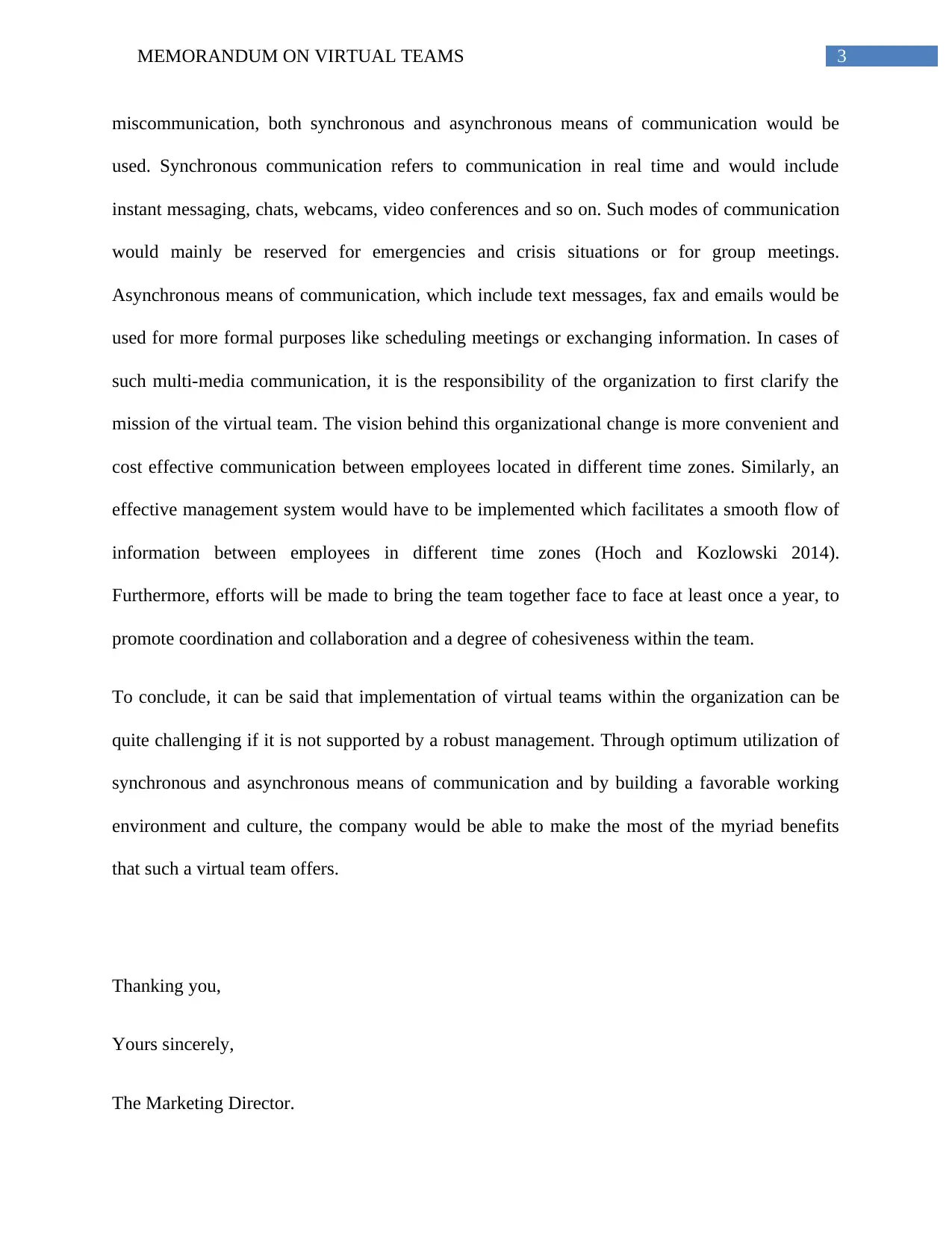
3MEMORANDUM ON VIRTUAL TEAMS
miscommunication, both synchronous and asynchronous means of communication would be
used. Synchronous communication refers to communication in real time and would include
instant messaging, chats, webcams, video conferences and so on. Such modes of communication
would mainly be reserved for emergencies and crisis situations or for group meetings.
Asynchronous means of communication, which include text messages, fax and emails would be
used for more formal purposes like scheduling meetings or exchanging information. In cases of
such multi-media communication, it is the responsibility of the organization to first clarify the
mission of the virtual team. The vision behind this organizational change is more convenient and
cost effective communication between employees located in different time zones. Similarly, an
effective management system would have to be implemented which facilitates a smooth flow of
information between employees in different time zones (Hoch and Kozlowski 2014).
Furthermore, efforts will be made to bring the team together face to face at least once a year, to
promote coordination and collaboration and a degree of cohesiveness within the team.
To conclude, it can be said that implementation of virtual teams within the organization can be
quite challenging if it is not supported by a robust management. Through optimum utilization of
synchronous and asynchronous means of communication and by building a favorable working
environment and culture, the company would be able to make the most of the myriad benefits
that such a virtual team offers.
Thanking you,
Yours sincerely,
The Marketing Director.
miscommunication, both synchronous and asynchronous means of communication would be
used. Synchronous communication refers to communication in real time and would include
instant messaging, chats, webcams, video conferences and so on. Such modes of communication
would mainly be reserved for emergencies and crisis situations or for group meetings.
Asynchronous means of communication, which include text messages, fax and emails would be
used for more formal purposes like scheduling meetings or exchanging information. In cases of
such multi-media communication, it is the responsibility of the organization to first clarify the
mission of the virtual team. The vision behind this organizational change is more convenient and
cost effective communication between employees located in different time zones. Similarly, an
effective management system would have to be implemented which facilitates a smooth flow of
information between employees in different time zones (Hoch and Kozlowski 2014).
Furthermore, efforts will be made to bring the team together face to face at least once a year, to
promote coordination and collaboration and a degree of cohesiveness within the team.
To conclude, it can be said that implementation of virtual teams within the organization can be
quite challenging if it is not supported by a robust management. Through optimum utilization of
synchronous and asynchronous means of communication and by building a favorable working
environment and culture, the company would be able to make the most of the myriad benefits
that such a virtual team offers.
Thanking you,
Yours sincerely,
The Marketing Director.
Paraphrase This Document
Need a fresh take? Get an instant paraphrase of this document with our AI Paraphraser
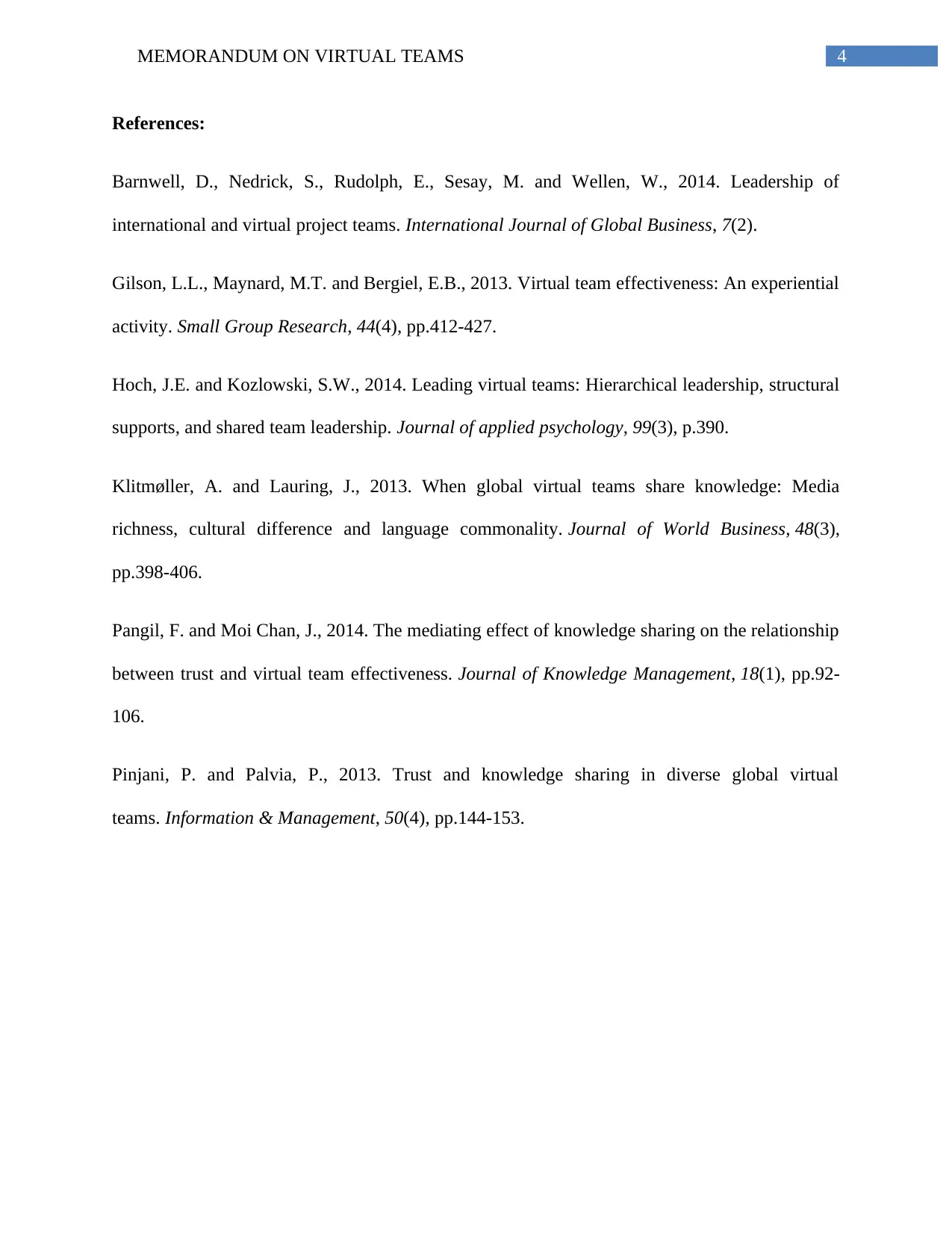
4MEMORANDUM ON VIRTUAL TEAMS
References:
Barnwell, D., Nedrick, S., Rudolph, E., Sesay, M. and Wellen, W., 2014. Leadership of
international and virtual project teams. International Journal of Global Business, 7(2).
Gilson, L.L., Maynard, M.T. and Bergiel, E.B., 2013. Virtual team effectiveness: An experiential
activity. Small Group Research, 44(4), pp.412-427.
Hoch, J.E. and Kozlowski, S.W., 2014. Leading virtual teams: Hierarchical leadership, structural
supports, and shared team leadership. Journal of applied psychology, 99(3), p.390.
Klitmøller, A. and Lauring, J., 2013. When global virtual teams share knowledge: Media
richness, cultural difference and language commonality. Journal of World Business, 48(3),
pp.398-406.
Pangil, F. and Moi Chan, J., 2014. The mediating effect of knowledge sharing on the relationship
between trust and virtual team effectiveness. Journal of Knowledge Management, 18(1), pp.92-
106.
Pinjani, P. and Palvia, P., 2013. Trust and knowledge sharing in diverse global virtual
teams. Information & Management, 50(4), pp.144-153.
References:
Barnwell, D., Nedrick, S., Rudolph, E., Sesay, M. and Wellen, W., 2014. Leadership of
international and virtual project teams. International Journal of Global Business, 7(2).
Gilson, L.L., Maynard, M.T. and Bergiel, E.B., 2013. Virtual team effectiveness: An experiential
activity. Small Group Research, 44(4), pp.412-427.
Hoch, J.E. and Kozlowski, S.W., 2014. Leading virtual teams: Hierarchical leadership, structural
supports, and shared team leadership. Journal of applied psychology, 99(3), p.390.
Klitmøller, A. and Lauring, J., 2013. When global virtual teams share knowledge: Media
richness, cultural difference and language commonality. Journal of World Business, 48(3),
pp.398-406.
Pangil, F. and Moi Chan, J., 2014. The mediating effect of knowledge sharing on the relationship
between trust and virtual team effectiveness. Journal of Knowledge Management, 18(1), pp.92-
106.
Pinjani, P. and Palvia, P., 2013. Trust and knowledge sharing in diverse global virtual
teams. Information & Management, 50(4), pp.144-153.
1 out of 5
Related Documents
Your All-in-One AI-Powered Toolkit for Academic Success.
+13062052269
info@desklib.com
Available 24*7 on WhatsApp / Email
![[object Object]](/_next/static/media/star-bottom.7253800d.svg)
Unlock your academic potential
Copyright © 2020–2025 A2Z Services. All Rights Reserved. Developed and managed by ZUCOL.



